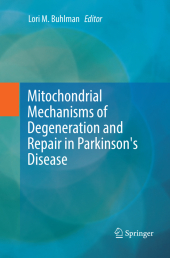 Neuerscheinungen 2018Stand: 2020-02-01 |
Schnellsuche
ISBN/Stichwort/Autor
|
Herderstraße 10
10625 Berlin
Tel.: 030 315 714 16
Fax 030 315 714 14
info@buchspektrum.de |

Lori M. Buhlman
Mitochondrial Mechanisms of Degeneration and Repair in Parkinsonīs Disease
Herausgegeben von Buhlman, Lori M.
Softcover reprint of the original 1st ed. 2016. 2018. xii, 275 S. 5 SW-Abb., 23 Farbabb., 23 Farbtabell
Verlag/Jahr: SPRINGER, BERLIN; SPRINGER INTERNATIONAL PUBLISHING 2018
ISBN: 3-319-82507-0 (3319825070)
Neue ISBN: 978-3-319-82507-6 (9783319825076)
Preis und Lieferzeit: Bitte klicken
This volume brings together various theories of how aberrations in mitochondrial function and morphology contribute to neurodegeneration in idiopathic and familial forms of Parkinsonīs disease. Moreover, it comprehensively reviews the current search for therapies, and proposes how molecules are involved in specific functions as attractive therapeutic targets. It is expected to facilitate critical thought and discussion about the fundamental aspects of neurodegeneration in Parkinsonīs disease and foster the development of therapeutic strategies among researchers and graduate students. Theories of idiopathic Parkinsonīs etiology support roles for chronic inflammation and exposure to heavy metals or pesticides. Interestingly, as this project proposes, a case can be made that abnormalities in mitochondrial morphology and function are at the core of each of these theories. In fact, the most common approach to the generation of animal and cell-culture models of idiopathic Parkinsonīs disease involves exposure to mitochondrial toxins. Even more compelling is the fact that most familial patients harbor genetic mutations that cause disruptions in normal mitochondrial morphology and function. While there remains to be no effective treatment for Parkinsonīs disease, efforts to postpone, prevent and "cure" onset mitochondrial aberrations and neurodegeneration associated with Parkinsonīs disease in various models are encouraging. While only about ten percent of Parkinsonīs patients inherit disease-causing mutations, discovering common mechanisms by which familial forms of Parkinsonīs disease manifest will likely shed light on the pathophysiology of the more common idiopathic form and provide insight to the general process of neurodegeneration, thus revealing therapeutic targets that will become more and more accessible as technology improves.
Mitochondrial ROS and Apoptosis.- Dopamine Metabolism and Reactive Oxygen Species Production.- The Consequences of Damaged Mitochondrial DNA.- The role of chronic inflammation in the etiology of Parkinsonīs disease.- Ion-Catalyzed Reactive Oxygen Species in Sporadic Models of Parkinsonīs Disease.- Toxin Mediated Complex I Inhibition and Parkinsonīs Disease.- Parkinson Disease-Associated Mutations Affect Mitochondrial Function.- PARKIN/PINK1 Pathway for the Selective Isolation and Degradation of Impaired Mitochondria.- Mitochondrial Therapeutic approaches in Parkinsonīs Disease.- Altering Mitochondrial Fusion and Fission Protein Levels Rescues Parkin and PINK1 Loss-of-Function Phenotypes.- Early Nicotine Exposure is Protective in Familial and Idiopathic Models of Parkinsonīs Disease.- Transcription Modulation of Mitochondrial Function and Related Pathways as a Therapeutic Opportunity in Parkinsonīs Disease.- Delivery of Biologically Active Molecules to Mitochondria.
Lori Buhlman earned her Ph.D. in Neuroscience from the University of Arizona and trained as a post-doctoral fellow at the Institut National de la Santé et de la Recherche Médicale, in Paris, France. She is currently an associate professor of Biomedical Sciences and Behavioral Medicine at Midwestern University in Glendale, Arizona, where she manages a research program exploring the mechanisms by which loss of Parkin function causes neurodegeneration. Her recent publications report that nicotine can protect against motor deficits caused by Parkin loss of function in Drosophila, and that Parkin and PINK1 work together to promote mitochondrial homeostasis in a manner that involves mitochondrial fission protein, Drp1.


